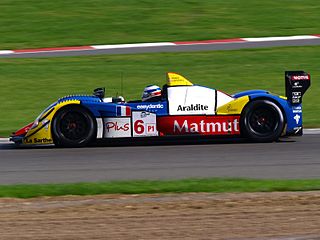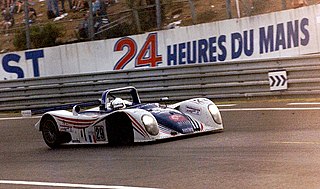This article relies largely or entirely on a single source .(June 2022) |
The Cougar C22 was a Group C sports car prototype used in the World Sports-Prototype Championship sports car racing series, from 1988 to 1989.
This article relies largely or entirely on a single source .(June 2022) |
The Cougar C22 was a Group C sports car prototype used in the World Sports-Prototype Championship sports car racing series, from 1988 to 1989.
The Cougar C20, a closed Group C prototype, was developed by Yves Courage in 1987 and prepared for the respective races by his own racing team, the Courage Compétition. Powered by a 2.8-liter Porsche 6-cylinder turbocharged engine, where it made its debut at the 24 Hours of Le Mans, and retired after 30 laps. The car's best result was a 6th-place finish at 1989 480 km of Dijon, which was also its best overall finish, being driven by Pascal Fabre and Jean-Louis Bousquet. [1] It was driven by Ukyou Katayama, François Migault, Paul Belmondo, Pascal Fabre, Hervé Regout, Jean-Denis Delétraz, Fabien Giroix, Oscar Manautou, Alessandro Santin, Jean-Louis Bousquet, Bernard de Dryver, Denis Morin, Bernard Santal, Patrick Gonin, and Jiro Yoneyama. [2] [3] [4] [5] [6]

Automobiles Gonfaronnaises Sportives was a small French racecar constructor that competed in various racing categories over a period of thirty years, including Formula One from 1986 to 1991.
Pascal Fabre is a former racing driver from France. He participated in 14 Formula One Grands Prix with the uncompetitive AGS team, debuting on 12 April 1987. He scored no championship points and was replaced before the end of the season by Roberto Moreno. His best finish was ninth place in both the French and British Grands Prix.

Courage Compétition was a racing team and chassis constructor company now owned by Oreca, based in Le Mans, France near the Circuit de la Sarthe. It was founded by Yves Courage, a French race driver who ran hillclimbs before founding the company. Following the purchase of Courage by Oreca in 2007, Yves Courage has refounded the company as Courage Technology in 2010, attempting to develop electric racing cars.

The Rondeau M382 was a Group C prototype sports car, designed, developed and built by Automobiles Jean Rondeau in 1981, and used in sports car racing between 1982 and 1986.
The Cougar C01, and its deriative, the Cougar C01B, were Group C sports car prototype race cars, designed, developed, and built by French constructor Cougar in 1984, and was used in sports car racing from 1982 to 1984. Its best result in the World Sportscar Championship sports car racing series was a tenth-place finish 1983 1000 km of Mugello, being driven by Yves Courage, Aldo Bertuzzi, and Gianni Giudici.

The Alpine A441 is a 2-liter Group 5 sports prototype racing car built by French company Alpine and co-developed by Renault to compete in the 1974 European 2 Liter Sports Car Championship. It was designed by French engineer and racing driver André de Cortanze.

The Courage C30, also known as the Courage C30LM, was a Group C2 sports prototype, designed, developed and built by French manufacturer Courage in 1993. It famously contested in the 1993 24 Hours of Le Mans, with drivers Derek Bell and Pierre Yver finishing in 10th and 11th place, respectively.

The Courage C36 was a Le Mans Prototype, designed, developed, and built by Courage Compétition team, to compete in sports car racing from 1996 to 1998. It is powered by a 3.0 L (180 cu in) 700 hp (520 kW) Porsche flat-six engine. It's best result was a 3rd-place finish at the 1997 FIA Sportscar Championship race at Zolder.
The Cougar C20 was a Group C sports car prototype used in sports car racing from 1987 to 1990.
The Cougar C24 was a Group C sports car prototype designed, developed, and built by French constructor Cougar, and used in the World Sports-Prototype Championship sports car racing series in 1990. Power came from a 3.0 L (180 cu in) Porsche 6-cylinder turbocharged engine. It's best result was a 7th-place finish at the 1990 24 Hours of Le Mans, being driven by Pascal Fabre, Michel Trollé, and Lionel Robert.

The Cougar C26 was a Group C sports car prototype used in the World Sports-Prototype Championship sports car racing series in 1991. Power came from a 3.0-liter Porsche 6-cylinder turbocharged engine. It achieved one podium finish; with its best results being a 2nd-place finish at the 1991 Most Interserie race, being driven by Frenchman Lionel Robert.

The Cougar C28 was a Group C sports car prototype used in the World Sports-Prototype Championship sports car racing series in 1992. Power came from a 3.0-liter Porsche 6-cylinder turbocharged engine. It managed to achieve an impressive 3 podium finishes and 1 class win. Highlights include an overall 6th-place finish at that year's prestigious 24 Hours of Le Mans, two third-place finishes and a sixth-place finish for Tomas Saldaña at the Interserie races in Jarama, Zeltweg, and Brands Hatch (respectively), and a third-place finish for Marco Brand at the Interserie race in Mugello.
The Cougar C12 was a Group C sports car prototype race car, designed, developed and built by French constructor Cougar in 1985, and used in sports car racing from 1985 to 1988. Its best result was an 18th-place finish at the 1986 24 Hours of Le Mans, being driven by Yves Courage, Alain de Cadenet, and Pierre-Henri Raphanel.
The Cougar C02 was a Group C sports car prototype race car, designed, developed, and built by French constructor Cougar in 1983, and used in sports car racing from 1983 to 1984. It was the successor the C01. Its best result was at the 1984 500 km of Watkins Glen, where drivers Yves Courage and John Jellinek, and Alain de Cadenet finished in 9th-place, respectively.

The Toyota 89C-V is a Group C sports prototype racing car, developed and built by Toyota intended to participate in the World Sportscar Championship, the 24 Hours of Le Mans, and the All-Japan Japanese Sports-Prototype Championship. The chassis is designed by Japanese company Dome. It is powered by a turbocharged 3.2 L (200 cu in) Toyota R32 V8 engine, producing 800 hp (600 kW). It won 2 races, scored 4 podium finishes, and clinched 3 pole positions.

The Rondeau M378 is a Group 6 sports prototype race car, designed, developed and built by Automobile Jean Rondeau, in 1978, and was their second car. It competed in one World Sportscar Championship sports car racing event; the 1978 24 Hours of Le Mans. It was driven by Bernard Darniche, Jacky Haran, Jean Rondeau, and its best result was a 9th-place finish at that year's event. It was powered by a 3.0 L (180 cu in), 460 hp (340 kW), Ford-Cosworth DFV V8 Formula One engine.The chassis is an aluminum-reinforced steel spaceframe, covered in a fiberglass panel body. This drove the rear wheels through a Hewland 5-speed manual transmission. This meant it was very light, with the total weight coming to 760 kg (1,680 lb).
The March 842 is an open-wheel formula racing car, design, developed and built by March Engineering, for Formula 2 racing, in 1984. It was powered by a 2.0 L (120 cu in) BMW M12/7 four-cylinder engine, producing 300 hp (220 kW). It contested in the 1984 European Formula Two Championship, where its best result was a win at Hockenheim, being driven by Pascal Fabre, followed by a 2nd-place finish later in the season, at Donington Park, being driven by Emanuele Pirro. Its best result in the championship that year was a 5th-place finish, for German driver Christian Danner that year.

The Reynard 2KQ was a Le Mans prototype built by Reynard Motorsport and used by various racing teams in sports car racing from 2000 to 2004.
The Welter-Meunier P82, and its successors and derivatives, including the P83, the P83B, and the P86, are a series of mid-engined Group C sports prototype race cars, designed, developed and built by French racing team Welter Racing, for sports car racing, between 1982 and 1986. The cars best result was a 6th-place finish at the 1982 1000km of Monza, being driven by Roger Dorchy, Guy Fréquelin, and Jean-Daniel Raulet. It was powered by a Garrett twin-turbocharged, 2.7 L (160 cu in), Peugeot PRV, V6 engine, producing between 600–890 hp (450–660 kW) @ 8300 rpm, depending on boost pressure, which drove the rear wheels through a 5-speed manual transmission. The chassis design was constructed into an aluminum monocoque, and the car weighed approximately 900 kg (2,000 lb).

The WR LM94, and its evolutions, the WR LM95, and the WR LM96, were a series of prototype sports car, designed, developed, built, and used by Welter Racing in the 1994 and 1995 24 Hours of Le Mans.